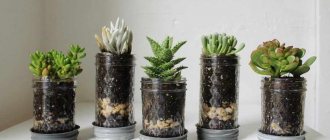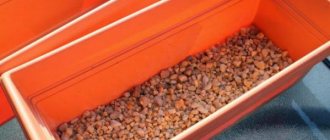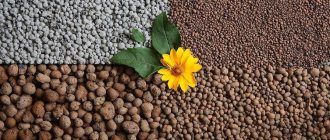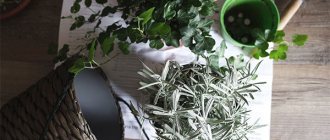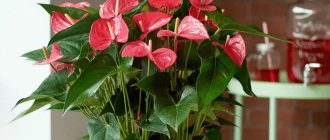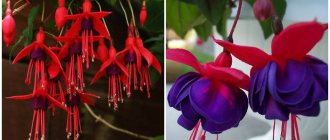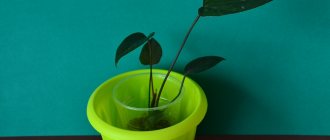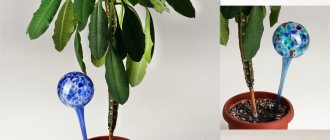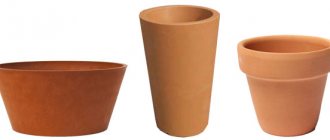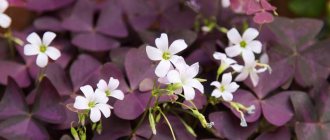Anyone who has been involved in planting plants at home understands perfectly well that drainage for indoor plants is a prerequisite for their rapid rooting and healthy growth after planting.
It is designed to remove excess moisture from the soil and provide air access to the roots. The drainage device is made using coarse-grained bulk material.
To make effective drainage for houseplants with your own hands, you must fulfill certain requirements for its equipment:
- moisture after watering should not accumulate in the pot, for which you need to make holes in it to drain excess water;
- the drainage layer should be laid first on the empty bottom of the pot or flowerpot so that there are no intermediate layers between the bottom and the nutrient soil that retain moisture;
- the thickness of the layer, which depends on the material used, the size and number of drainage holes, should ensure good outflow of water and free flow of air to the roots;
- the degree of soil drainage for each plant is selected individually
, for example, for cacti and succulents you need fast drainage in a pot with a large number of holes and loose soil, and for a moisture-loving flower, moderate soil drainage that retains moisture is suitable; - equipment of the drainage layer should be carried out with your own hands, adhering to a certain order, starting with the coarse, then the medium and ending with the small fraction. Upon completion of installation, shake the pot to eliminate any remaining voids between the particles of material;
- After watering the seedlings, the holes in the pot should not be clogged.
Directory of indoor plants
What is drainage? Why is it needed? Which one is better to use? Read in today's article, is it possible to use polystyrene foam as drainage?
Drainage is used as the first layer or substrate for planting indoor plants. It ensures rapid drainage of moisture. In most recommendations, drainage is mandatory. What ingredients can be used as a basis for creating a drainage layer?
Drainage can be:
- Expanded clay;
- Vermiculite;
- Clay shards;
- Sand;
- Pebbles;
- Hydrogel;
- Styrofoam;
Depending on the needs of the plant, different materials are chosen to create a drainage layer. In today's article we will look at polystyrene foam.
Is it possible to use polystyrene foam as drainage: absolutely. The material is lightweight, safe for plants, perfectly permeates moisture, loosens the soil, and performs its functions. Even if plant roots grow into it, the foam can be easily removed by hand during the next replanting.
How to use foam for drainage:
- Place drainage made of foam plastic broken into pieces on the bottom of the cleaned pot;
- Calculate the proportions, for example, 1:2 with the soil mixture;
- Pour previously prepared soil over the drainage;
- Plant the plant so that its roots do not come into contact with the drainage;
The home flower can continue to be watered and fed using the same method as without the foam drainage layer - the component we are interested in will fully perform its functions. If drainage is needed for stability, then a couple of large stones or medium-sized pebbles are added to the polystyrene foam in a 50/50 ratio, and, if recharge is needed , pieces of charcoal are added. Don’t be afraid to combine several types of drainage - the components will complement each other and create a diverse care effect.
- Note: in addition to the drainage elements inside the pot, which are laid out on the bottom, there should also be drainage holes in the pot itself. These types of containers often have a drip tray attached to drain the water.
Advantages of the Sofrock system
“Softrock” has many advantages in comparison with traditional drainage using crushed stone.
- Inexpensive and quick installation . The blocks are very flexible and light weight, which greatly simplifies their installation in a prepared trench. It is necessary to equip a place for water drainage; it is advisable to fill the drainage with sand on top, especially on clay soil. The use of expensive special equipment is not required for transportation and installation.
- High drainage efficiency . The water in the area does not stagnate. Geosynthetic filler ensures its rapid and efficient collection into the system. “Sofrock” can withstand the weight of earth 2.5 m high and the weight of cars up to 25 tons. The system will last more than a hundred years, is not afraid of temperature changes, does not freeze, adapts to any climatic conditions, is very reliable, can be reused, does not silt or clogged.
All that remains is to fill the drainage ditches with earth and cover them with turf Source udachnyi.ru
- Preservation of the site and buildings . After installation, there is no dirt, debris from construction materials or traces of heavy special equipment left on the site, the overall landscape and lawn are preserved.
Purchasing Softrock is much more profitable than purchasing any analogues. The drainage pipe with polystyrene foam is laid very quickly. There are no additional costs for the use of special equipment for delivery and installation of the system and additional materials. Inexpensive, but short-lived and low-quality polystyrene or reliable and durable polystyrene can be used as a filler.
Even if any unforeseen accident occurs, the system can be cleaned through inspection wells Source tunwma.com
The nuances of using polystyrene foam
Different plants need different fractions (sizes) of drainage. The advantage of polystyrene foam is that it can be broken into both large and small pieces, or even completely crumbled. If the plant needs a long supply of moisture, drainage foam is mixed with sphagnum moss. You can also add crushed stone, expanded clay, and brick for better loosening. Bulk plants in large pots may suffer from a lack or excess of water - it is not always possible to monitor how quickly the water will pass, and much depends on the microclimate in each individual house. What to do? Add granular or regular hydrogel to the foam. Literally a couple of pieces is enough to control the moisture.
Hydrogel is another great ingredient to look out for. Hydrogel for indoor plants . Paired with polystyrene foam, it will become a good helper and will relieve anxiety about the condition of the plant, eliminating the need for frequent checks of the condition of the flower.
Read also: Which mayonnaise is best for salads
↓ Write in the comments, is it possible to use polystyrene foam for plants? What else would you replace drainage with?
Please rate the material you read :)
Fire hazard
Once you become interested in using polystyrene foam for flower pots, you can start collecting it anywhere and everywhere. Packaging boxes and other products are sometimes brought home literally from a landfill.
It is not worth keeping such a quantity of flammable material at home. A stack of foam plastic sheets stacked on a balcony or in the corner of a hallway is quite a fire hazard: a spark from a cigarette can easily fall on it.
Can foam plastic be used as drainage? : One comment
Very informative and useful article! I’ve never used polystyrene foam before, I heard from friends that it can be useful when replanting indoor flowers, I’m going to replant Zamioculcas, and I’m very worried about inadvertently harming my beloved flower, I’ve had it for a year now, I shot two large arrows (I that’s what I call it) but I thought that there wasn’t enough space for it, and I wanted to replant it. To avoid unpleasant consequences, I started looking for help sites, thank you very much for such a detailed description, ten points to you, and good luck.
Healthy appearance and abundant flowering often depend on the use of drainage for indoor plants. Flowers without a drainage layer grow poorly, get sick and die over time. It is not difficult to make drainage yourself. The materials for the day are often already in your home.
Drainage and its purpose
Many houseplants require a soil composition that provides approximately 50% solids, 35% water and 15% air. Only a properly laid drainage layer will help recreate optimal conditions for growth and flowering.
The problem with lack of drainage is that overwatering displaces air, which is vital for flowers. The lack of oxygen in the soil provokes the development of pathogenic bacteria. The root system begins to rot and the plant withers. The drainage layer ensures the outflow of excess moisture and good breathability.
Indoor plants and drainage in pots
What materials are not suitable for drainage?
- You cannot use organic substances, for example, tree bark, sawdust, egg or nut shells, etc. Their disadvantage is their susceptibility to rotting, mold and fungi growth under the influence of moisture. This affects the acidity of the renewed soil after plant transplantation, contributes to the development of various diseases in them, and can lead to their death.
- It is not recommended to use river sand, which easily becomes clogged with soil microparticles and quickly loses its drainage properties.
- It is strictly forbidden to use granite and marble chips, sawdust from slabs, which contain mineral salts that interact with water when watering and lead to alkalization of the soil.
To increase the efficiency of the drainage layer, it is necessary to remove excess water from the pan after watering to ensure air access to the roots. After each plant transplant, the drainage should be replaced with new material.
Polystyrene foam for flowers
What can be used as drainage
To lay drainage, you can use materials such as gravel, expanded clay, crushed stone, broken brick, peat, charcoal, river sand, polystyrene foam or any synthetics. An important quality of the drainage layer for indoor plants is good moisture permeability, inertness to chemicals, resistance to rotting and mold.
Drainage has different fractions, which are selected depending on the flower.
Expanded clay for flowers
A material with a porous structure, expanded clay, is baked clay. It is used in construction as an effective sound insulator and insulation. In floriculture, fine- and medium-fraction expanded clay is used. The main advantages are lightness and ability to absorb water. When the earthen ball dries out, the material releases moisture back into the soil.
Expanded clay is a chemically neutral, odorless material. It can be used several times. After about 6 years it crumbles into the ground. For drainage of large indoor plants, medium-fraction expanded clay (diameter 2 cm) is suitable. It is important that the size of the hole at the bottom of the pot is smaller than the fraction of the material. The optimal height of the drainage layer is 2 cm. If you are using a container without holes, then the expanded clay layer should be 5 cm. Sprinkle sand on top.
Layer of expanded clay in a pot
Ceramic shards
Pieces of ceramics will serve as a good drainage material for indoor flowers. Place several small shards or large pieces with the convex side up on the holes in the pot. Pour 1.5 cm of purified coarse sand on top into a small container, and 5 cm into a large container. The disadvantage of the material is the risk of damage to the roots by the sharp sides of the shards. You should not use pieces of ceramic that are too large, as sand will spill through them.
Ceramic shards
Perlite and vermiculite
The material vermiculite is produced by heating clay to high temperatures. As a result of heat treatment, minerals are pressed together, forming flakes. In appearance, vermiculite resembles wood or cork shavings. It is light, inert, and does not harm indoor plants.
Read also: DIY Christmas toys made from scraps
Perlite is elastic silica of volcanic origin. It appears as white or gray granules. Both materials are capable of absorbing moisture with mineral and organic substances. They return water back to the soil as needed. The disadvantage of this type of drainage is its high cost.
Perlite and vermiculite
Sphagnum moss
Many gardeners use pure sphagnum moss as a drainage material. This natural drainage holds water well and releases it to dry soil. In addition, it has disinfecting properties. Moss grows on moist, swampy forest soils. It consists of soft stalks of light green light, from which the same soft needle-like leaves grow to the sides.
Sphagnum moss can be harvested in any season, but it is preferable to do it in the fall: this way it will better retain moisture during transportation. Before laying the drainage, the moss is filled with warm water (temperature about 45 degrees). This procedure saturates the material with moisture and gets rid of possible insects.
Store moss in the refrigerator or freezer. The material is first placed in a plastic bag, but not tightly closed to allow air access. It is important to note that when defrosted, moss does not lose its beneficial qualities. The only disadvantage of the material is its inaccessibility. It is not always available in flower shops, and getting to the forest for it is not always possible.
Sphagnum moss
Charcoal
Charcoal drains the soil well for indoor plants. It functions as a natural fertilizer and antiseptic. Charcoal prevents putrefactive processes, adsorbs salts, and regulates soil moisture saturation. Charcoal drainage also absorbs and retains water and minerals well.
Charcoal is a neutral, inert, lightweight and porous material. For drainage, it is laid out on the bottom of the planting container in a two-centimeter layer. It is advisable to take large fractions or such that they do not pass through the holes of the pot.
Charcoal drainage in a pot
Crushed stone and gravel
Good drainage for flowers is obtained from medium-sized fractions of crushed stone and gravel. These materials are perfect for small pots with indoor plants that are rarely replanted and moved from place to place. The main disadvantage of crushed stone and gravel is their heavy weight.
Gravel for turf
Broken brick
Broken clay brick is another option for good drainage for flowers. During production, various additives are added to the clay to improve its quality, and then fired. As a result, the natural material is strong and absorbs moisture well.
The main disadvantage is the sharp edges of broken bricks, which can damage the roots of a houseplant. It is better to sharpen the pieces a little before storing them. Instead of red ceramic brick, you can use silicate brick. It has more pronounced drainage properties.
Broken brick
Foam drainage
Foam can be used as a drainage layer. In every home there is at least one box of household appliances containing this material. Polystyrene foam is lightweight, does not absorb water, does not decompose, does not deform, is non-toxic, and has no odor. It is good to use in heavy ceramic flowerpots.
Excess moisture flows down the foam into the tray. To lay drainage, the material is cut into cubes and placed on the bottom in a layer of 2 cm. The disadvantage of polystyrene foam is that over time, the roots of indoor plants entwine the material. In view of this, when replanting there is a danger of damaging the root system.
Polystyrene foam as drainage
Sea or aquarium stone
An alternative to crushed stone and gravel is small sea or aquarium stone. It is great not only as a drainage layer in a pot, but also for decorating the soil of a houseplant. The only thing that can discourage a gardener from purchasing such drainage is the high price.
Read also: Auger snow shovel
Sea stones as drainage for a flower
Ceramic ware fragments
High-quality ceramic dishes are very similar in properties to expanded clay, so fragments of various pots and jugs are quite suitable for creating drainage.
This material is chemically neutral and has a fairly large weight. Thanks to this, it not only removes excess moisture, but also makes the pot more stable. In addition, ceramics can be easily broken into pieces of the desired size with a regular hammer.
Why are drainage holes needed in a flower pot?
In addition to proper drainage, it is important to find a good pot for planting. When purchasing a container, pay attention to whether it has drainage holes, what size they are and how they are located. If the holes are too small, the moisture will drain slowly, if they are large, the moisture will drain quickly. If there are no holes at all, they can be made at home using a drill with a suitable drill diameter.
To ensure the correct soil moisture for certain indoor plants, you should choose a container with the correct holes:
- For succulents, cacti and some types of orchids, moisture must drain quickly. A small pot with porous soil and small holes is suitable for them.
- For plants growing in high humidity, it is better to select containers with dense soil and a minimum of small holes.
Drainage holes in flower pots
How to make a drainage layer
When the drainage material and planting container are prepared, you should proceed to installation. Step-by-step instructions on how to make drainage in a flower pot at home:
- Before starting work, make sure that all tools are clean and disinfected. Containers for planting must be dry.
- Before installation, carefully read the instructions for the drainage material; some of them require pre-soaking.
- Be sure to replace the drainage material with a new one when planting, transplanting, including during emergency procedures. If crushed stone or expanded clay is used, they should be washed, disinfected, dried, and then reused (maximum service life is 6 years).
- Select the layer height depending on the requirements of a particular plant. If the care recommendations do not indicate what kind of drainage is needed, then use low or medium. The usual drainage layer is 1–3 cm, medium – 4–5 cm, high – more than 5 cm.
- Adjust drainage height based on the number and diameter of drainage holes if necessary. If there is 1 large hole in the pot, then increase the minimum layer to 3 cm. For small holes, only high drainage is suitable. If there are many holes and they are large, then limit yourself to a layer 1 cm high.
- It is important that the drainage material lies evenly. To do this, tap the pot on the sides or shake it a little. If you are using shallow drainage, add a thin layer of soil on top. For coarse drainage material, add coarse sand.
- Completely cover the drainage layer and level the soil or sand. After this, proceed to transshipment or planting of a house plant.
Drainage layer
"Sofrock" - a profitable alternative
The drainage system without crushed stone "Softrock" is elements completely ready for installation, which significantly reduce labor costs and save time when arranging high-quality and durable drainage. The system includes the following elements:
- clamps and couplings, purchased separately, are used to connect pipes;
- geotextile mesh;
- pipes (perforated, flexible), around polystyrene foam.
The length of each block is 3 m, while the pipes can be 11-20 cm in diameter, the outside diameter is 30 cm. The design itself is much more effective than any analogues using crushed stone. Foam channels improve water flow; the problem of silting is eliminated thanks to the geotextile mesh.
Connecting drainage system blocks Source udachnyi.ru
Errors in the manufacture of drainage
Flower growers often make mistakes when making drainage:
- Do not use fine sand, which will clog the water drainage holes over time.
- You should not use large fractions, which do not retain moisture at all, and it immediately flows into the pan.
- Do not use natural materials that tend to rot, such as sawdust or tree bark. The rotting process often provokes plant diseases.
- It is not advisable to use marble chips. This material, when interacting with water, changes the acidity of the soil.
- It is not recommended to use materials with sharp edges: they can damage the root system of the plant.
Foamed polystyrene foam.
Its popularity among the masses is due to its low cost and high thermal insulation characteristics. Builders especially like this material, due to the fact that it is very easy and quick to work with (today, no one is foolish to overexert themselves).
Expanded polystyrene is a synthetic material that is produced by the chemical industry, and everyone has probably had the idea that such an artificial material cannot be completely harmless to health
. But, usually, a person prefers to replace healthy prudence with instructions and assurances that the material is absolutely inert and safe (what else should he “sing”? :)).
